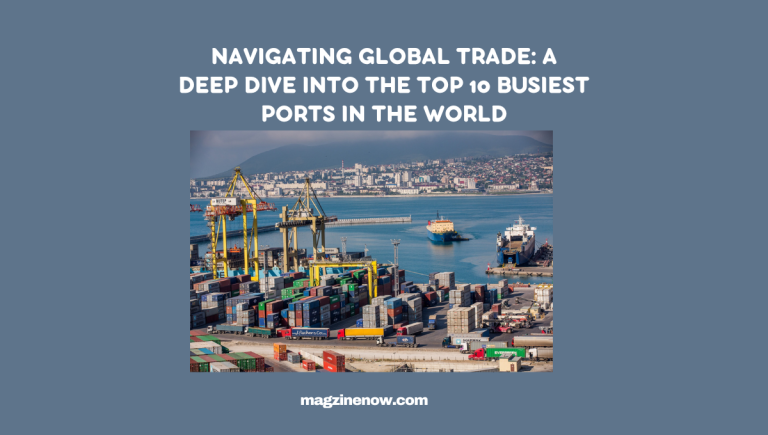Introduction:
Smooth seaports are of key importance to the world’s international trading environment. They serve as leverage points for product flow, stimulating economic development and enhancing communication between countries. The transportation industry plays an important role in the international trade of goods, while some ports are true bonanzas. This article will focus on the ten busiest ports in the world, their importance; operating scope, and even worldwide economic influence.
Table of Contents
Port of Shanghai, China:
(Image Source:LLoydslist)
Shanghai, close to the mouth of the Yangtze River, is now one of the world’s busiest ports. It is the gateway for imports and exports, an important step in China’s rapid economic growth. There are all kinds of terminals at the port. One is Yangshan Deep Water Port with its modern facilities. The Port of Shanghai’s advantageous position combined with a sturdy infrastructure makes it an indispensable link between China and the international market.
Port of Singapore:
(Image Source:Nepia)
The Port of Singapore, which plays such a big role in world trade, is proof of the nation-state’s devotion to maritime superiority. Since Singapore lies at the crossroads of major shipping lanes, it is also an important transshipment center. Its status as one of the busiest and most technologically advanced ports in the world is achieved through its efficiency, modern technology, and high-class facilities. The Port of Singapore is an indispensable link between Asia and the Americas, Europe, and other countries.
Port of Shenzhen, China:
(Image Source : Llloydlist)
The Pearl River Delta’s Port of Shenzhen lies within China’s coastal economic belt. It is made up of many container terminals, such as Yantian International Container Terminals and Shekou Container Facilities. China’s industrial sector is expanding, and that has produced outstanding growth for the Port of Shenzhen. In addition to being right next door to Hong Kong, Japan’s closer integration into China’s wide net of rail and road lines strengthens its position in international trade.
Port of Ningbo-Zhoushan, China:
(Image Source: Splash247
A key East Asian marine gateway The Port of Ningbo-Zhoushan, in the province of Zhejiang. Its advantageous location close to Shanghai and the Yangtze River Delta has greatly facilitated its fast growth. The port complex includes Ningbo Port and Zhoushan Port, which handle a wide variety of cargo from containers to bulk items. With continuous investments in technology and infrastructure, China’s Port of Ningbo-Zhoushan remains an important part of the marine environment.
Port of Hong Kong, China:
(Image Source :Wikipedia)
Hong Kong is a renowned international trading and financial center, with one of the busiest ports in all the world. For such an important transshipment center, the Port of Hong Kong has long been playing a key role in East-West communications. Hong Kong’s geostrategic position, running of efficient operations, and pursuit of innovation all have contributed toward that it has managed to cling onto the wings among global ports.
Port of Busan, South Korea:
(Image Source: Ship Technology)
Busan, on the Korean Peninsula’s southeast tip, is now certainly a gateway to Northeast Asia. Its success in the field is due to its excellent location, ideal infrastructure, and efficient operation. The port handles a wide range of cargoes, from bulk products to cars and containers. Busan’s role as a transshipment center for several international routes also serves to emphasize the Port of Busan’s importance.
Port of Rotterdam, Netherlands:
(Image Source: Safty4sea)
The Port of Rotterdam, thanks to its central European location, is an essential part in the world’s supply chain. A huge harbor like Rotterdam naturally handles a lot of cargo. The biggest items are refined petroleum products, containers and crude oil. Its advanced infrastructure, which includes massive warehouses and deep-water ports for moving commodities in and out of Europe, makes it easier to move commodities into the European market. Its position, combined with its commitment to environmentalism, is what make the Port of Rotterdam such a durable powerhouse.
Port of Guangzhou, China:
(Image Source : Seatrade Maritime)
As China has become the world’s manufacturing center, so too has its Pearl River Delta Port of Guangzhou grown. Guangzhou’s port complex includes terminals handling various types of cargo, such as Huangpu Port and Nansha Port. The Port of Guangzhou, which has several railway and highway connections moving in different directions, is an entry gateway to Southern China. Its role as a main distribution center for global commerce cannot be questioned.
Port of Qingdao, China:
(Image Source :Alamy)
Located on the Yellow Sea, Qingdao Port has become one of China’s largest seaports. Its strategic location makes trade with Northeast Asian nations and other countries possible. Many commodities pass through the port of Qingdao, such as coal, iron ore, and containers. The port is a shining star amid China’s marine atmosphere, through both technical innovation and effective operations.
Port of Tianjin, China:
(Image Source: Seatrade Maritime)
Tianjin, situated to the southeast of Beijing, is one of Northern China’s major entry points. Twenty-eight specialized terminals include the Tianjin Five Continents International Container Terminal and the Tianjin Port Container Terminal. Its port of Tianjin One of China’s economic superpowers, the Beijing-Tianjin-Hebei area is highly dependent on shipping. The Port of Tianjin is expanding and modernizing its infrastructure continuously. As a result, both the port’s capacity and effectiveness are increasing every year.
FAQs About Top 10 Busiest Ports in the World
1. How were the top 10 busiest ports determined?
These factors include total cargo throughput, container handling capacity, and efficiency as well as global connectivity. The ports were evaluated in terms of their impact on international trade and how they promoted global commerce.
2. But why do Chinese ports appear so conspicuously in this list?
Owing to China’s rapid economic development, large manufacturing base, and strategic geographical location the list is dominated by Chinese ports. Shanghai, Shenzhen, and Ningbo-Zhoushan are now giant links in the global supply chain. Ever-increasing volumes pass through their ports.
3. Why are transshipment hubs in the top 10?
Transshipment hubs such as the Port of Singapore and Port of Hong Kong are an important link between regions. They are important nodes on shipping networks, besides allowing goods to be easily exchanged between vessels.
4. What role do European ports such as the Port of Rotterdam play in world trade?
The continent’s gateways are European ports, particularly the Port of Rotterdam. Because of this, Rotterdam can effectively handle all kinds of cargo. It is connected to the entire world through its advanced infrastructure and a variety of transportation networks, which also make it one more connecting port between Europe and other countries around the globe.
5. How do these ports manage to maintain their status as the busiest in the world?
These challenges include a need for ever-increasing infrastructure to match expanding cargo volumes; environmental problems, and the required adjustment of technical standards. Competition among ports also requires innovation and improvements in efficiency.
Conclusion:
The world’s top ten busiest ports are the arteries of international trade, carrying commodities that nourish national economies and change industries. As a place where countries and continents are united, each port has its function. You have the busy ports of Singapore and Shanghai; you also have several vital hubs in South Korea, Holland, Europe, and elsewhere. With technology, infrastructure, and sustainability on the rise securing free movement of goods will become ever more important in international commerce. Only by doing that can we achieve global economic growth.



















